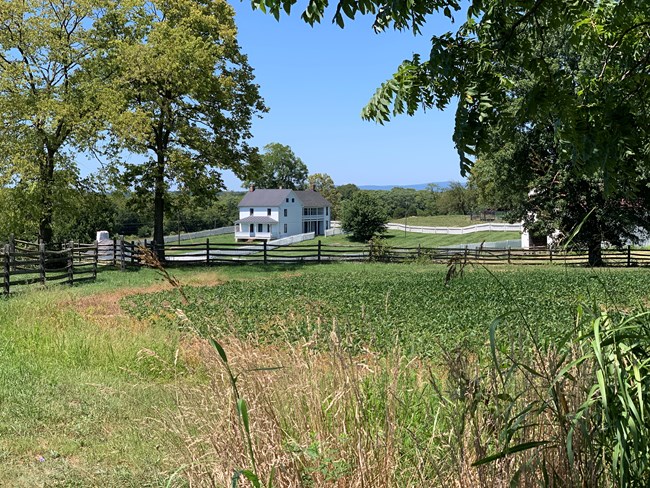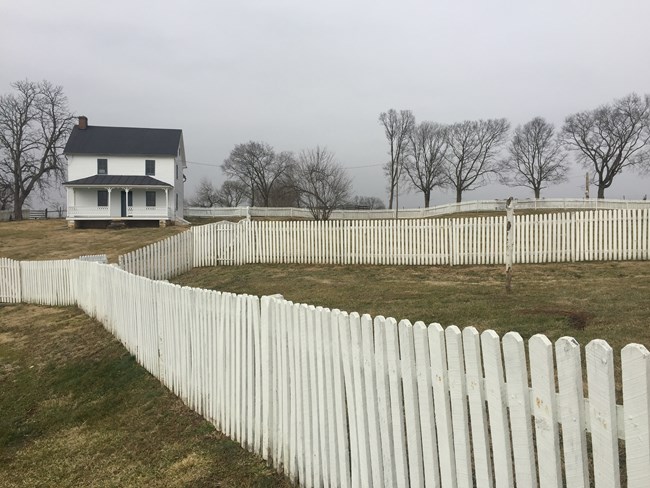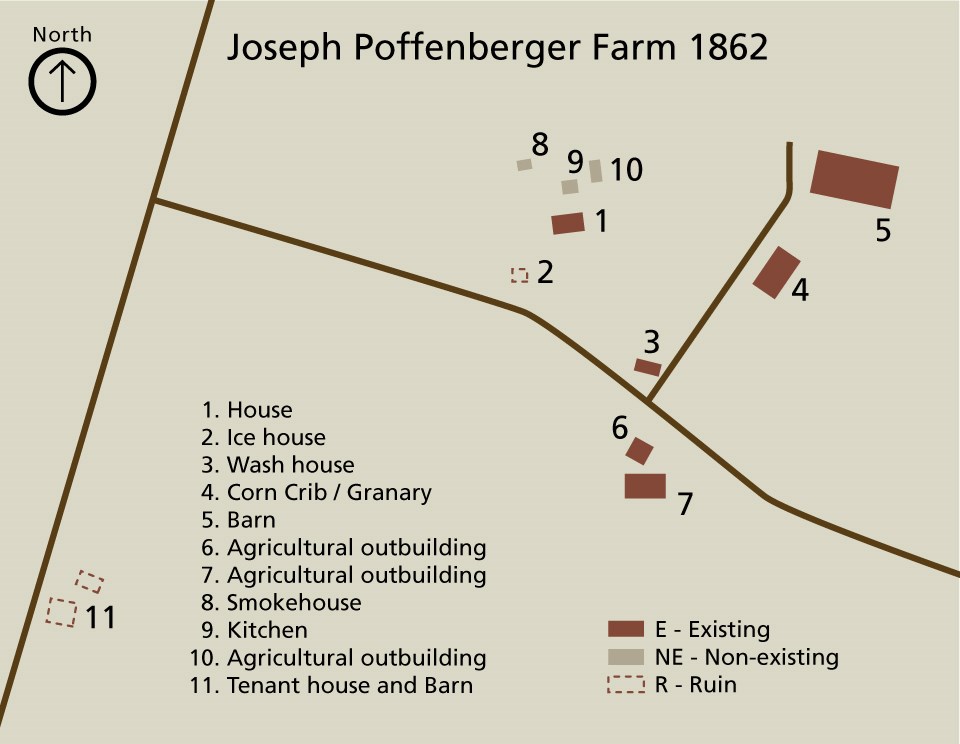The Joseph Poffenberger Family and FarmWhen the Civil War began in 1861, Joseph Poffenberger and his wife Mary Ann had no way of knowing that it would arrive on their doorstep nearly a year later. Their home sits just a few miles north of Sharpsburg, Maryland. By September of 1862 their house and belongings would be claimed by the greatest conflict our country has ever experienced. Today, their home and property sit empty but are maintained and preserved by the National Park Service. However, the story of the Poffenberger family and farm continues. 
Antietam/NPS Photo Historical Ownership and Structural ChangesOriginally the plot of land where the Poffenberger farm sits today was owned by James Chapline, son of Sharpsburg founder Joseph Chapline, in the late 1700s. The nearly 1400-acre plot of land would eventually be divided and leased or sold in family-sized tracts. Nearly 272 acres would eventually be sold to Christian Middlekauff. Through this time a house, shed, wash house, wagon shed, and corn crib were constructed. From 1813 to 1833 the property exchanged hands among the Middlekauff family and their spouses. In 1833 the farm was owned by Daniel Nekirk, husband of Rosanna Middlekauff. Daniel mortgaged the farmstead to nearby neighbor, Jacob Coffman as insurance for a loan of $3,000 dollars, due to paid over the span of 10 years. Daniel constructed a bank barn, equipment shed, icehouse, and smokehouse to expand the farmstead, suggesting that Daniel was using the money to make improvements on the farm. By the fall of 1833 both Daniel and Rosanna Nekirk would pass away, leaving Jacob Coffman to take ownership of the property in 1843. Jacob Coffman would remain the sole owner until 1852 but by 1850 the United States Census listed Joseph and Mary Ann Poffenberger as the residents of the home. Two years later, the property was officially sold to Joseph Poffenberger. By 1880 Joseph Poffenberger turned over managing of the farm to his nephew Otho Poffenberger and his wife Elizabeth. When Joseph passed away in 1888 Otho purchased the farm, updated the house, and constructed an addition to the back of the main house. Otho continued to live on the farm until his death in 1932. During Otho’s ownership the United States War Department purchased a tract of land that runs across the front of the property in order to construct a tour road, known today as Mansfield Avenue. This road allowed the War Department to erect historic markers, tablets, and monuments dedicated to the fighting that occurred in this area. After Otho’s passing in 1932, by another Joseph Poffenberger, Otho’s son, purchased the property. In 1944 Joseph Poffenberger deeded the property over to his relative, Elmer Poffenberger who remained the owner until 1966. Fred and Renee Kramer were the last private owners of the property and on June 8, 2000 the National Park Service purchased the land and structures. Under the Park Service’s ownership, the structures were stabilized and restored to their 1862 appearance. The only structures missing are the smokehouse, kitchen and the tenant house. 
“I had nothing left.” The Battle of AntietamBy September of 1862, the Poffenbergers had worked for months to fill their barn with stores of food, large stacks of hay to feed their livestock filled the loft. Orchard trees were loaded with apples, peaches, and plums. The store house was stocked with smoked meat. They had every reason to believe that winter of 1862 would be spent comfortably. Joseph and Mary Ann had no children of their own, but they did allow several members of their extended family to stay with them over the years. In 1862 their nephew Josiah and an orphan they had taken in, Isaac Mallott, were both living on the property. On September 16th, soldiers warned many of the residents around Sharpsburg of the coming battle. Thousands of troops streamed onto the field from Boonsboro, Maryland after the battle of South Mountain and soon the armies would re-engage the fighting around Sharpsburg. Many of the Poffenberger’s neighbors fled a few miles north to the Manor Church, which was of the same denomination as Antietam’s Dunker Church. It is unknown where Joseph and Mary Ann sheltered during the battle. The area around Sharpsburg was home to many of their relatives so it is possible they might have stayed with family until the danger had passed. By the evening of the 16th hundreds of soldiers of Union General Joseph Hooker’s I Corps had arrived in the area around the Poffenberger farm. They had been ordered to cross the Antietam Creek that evening; once across they set up camp around the Poffenberger home. The high ground just north of the farm became an ideal location for Union artillery and the barn became headquarters for Joseph Hooker as his men settled in for the night. Some of Hooker’s men skirmished with the left flank of the Confederate line in the woods just south of the Poffenberger property on the evening of the 16th, but the real fighting erupted the next morning. As the sun began to rise on the morning of September 17th, Confederate cannons on the Dunker Church plateau and Nicodemus heights opened fire on the soldiers around the Poffenberger farm. As the First Corps surged forward toward the Confederate line, the area quickly transformed from a camp to a field hospital as the injured were brought back from the front lines. As Union surgeons worked tirelessly to treat as many of the injured as they could, they quickly exhausted their supplies. Around noon, the Poffenberger farm received another historic visitor, Clara Barton and her wagons of much needed medical supplies. More information about her can be found here. AftermathAfter the fighting was over and Lee had retreated across the Potomac, Joseph and Mary Ann returned to their home. They found weary Federal soldiers camping all over their property and discovered that nearly all their belongings stolen or destroyed. Joseph recalled “I returned to my house; it was completely empty. I had nothing left. I lived on army crackers that I found on the battlefield for five days.” 1 The Union army would stay encamped on the Poffenberger property until late October. In that time soldiers continued to devour the stores of food and livestock that belonged to the Poffenberger family. According to the claim that Joseph filed against the Federal government his losses included: Joseph Poffenberger claimed it was valued at $2,277.53 but it was “disallowed” by the government because they could not prove what was originally in their or that the United States Army had taken all the missing supplies. Joseph Poffenberger never received any reimbursement from the government. Over thirty years later, in 1893, the estate was finally awarded $1918.00 in compensation for Joseph’s war claim. Today Joseph and Mary Ann are both buried in the Mountain View Cemetery in Sharpsburg, Maryland. Mary Ann passed away just two years after the Battle of Antietam, and it is possible that her death was caused by an increase in disease due to the unsanitary conditions and mass burials around Sharpsburg. Disease was not only the biggest killer of soldiers during the war but was also responsible for the deaths of many of Mary Ann’s neighbors. Joseph Poffenberger would never remarry and was buried next to his wife on June 13, 1888 at the age of 76. Today visitors can still walk the grounds of Joseph and Mary Ann’s home. The house and exterior buildings sit empty today, in order to protect the resources and visitor safety the structures are no longer accessible. The surrounding land is leased by the Park Service to local farmers so long as they plant period-accurate crops. Today, the farmstead serves as a window into the past, allowing park visitors to see a near perfectly preserved farmstead of Sharpsburg from the 1860s. 
NPS Map/K.Snyder |
Last updated: September 15, 2023
